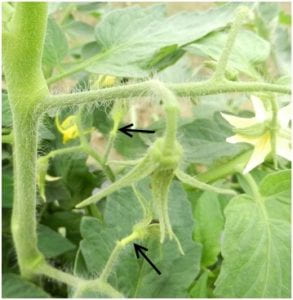Jerry Brust, IPM Vegetable Specialist, University of Maryland;jbrust@umd.edu
The high temperatures we will have this week with daytime highs 90oF and above and nighttime lows only getting down to 70oF in much of the mid-Atlantic for several days in a row may cause blossom drop and fruit abortion in tomatoes. Normally in tomato fields, pollination is achieved just by the action of the wind. Pollen is released from the tomato flower and falls downward onto the stigma. Without pollination flowers die and drop. This condition can affect tomatoes, peppers, snap beans, and other fruiting vegetables, but is especially prominent in tomatoes. In tomatoes, blossom drop is usually preceded by the yellowing of the pedicle (Fig. 1). Tomato flowers must be pollinated within 50 hours or they will abort. This is about the time it takes for the pollen to germinate and move up the style to fertilize the ovary. Tomato plants can tolerate extreme temperatures for short periods, but several days or nights with temperatures above 90oF (daytime) or 72oF (nighttime) will cause the plant to abort flowers and fruit (Fig. 2). At these temperatures the pollen can become sticky and nonviable, preventing pollination from occurring and causing the blossom to dry and drop. The relative humidity also plays a role in pollination, high levels (>80% RH) (which we had and will have this week) during pollen shed will cause the pollen not to be released properly resulting in poor or incomplete pollination.
There are some possible remedies to these high temperatures that could increase pollination and fruit set that the vegetable group is working on this year. One of the things I have been working on the last several years is using shade cloth that is draped over the tomato stakes when plants begin to set fruit (Fig. 3). Two years ago when we had a very hot dry summer yields were increased in the shaded areas by an average of 32%, quality and size of tomatoes increased significantly when the same variety was shaded vs. when it was not (Fig. 4). Last year when it was not very hot and we had good rainfall throughout the summer yields still increased in the shaded areas vs non shaded areas by 12-15%. I do not think a grower should go out and cover all of their tomato fields with shade cloth, but it could be used for tomato varieties that you grow because your customers really like them, but they just do not produce well in the summer heat. There are some other trials we are conducting to help tomatoes and other vegetables come through the heat, but those results will have to wait for this winter.
Figure 1. Several flower pedicels turning yellow (arrows).
Figure 2. Aborted flowers and fruit (arrows) on tomato plant caused by high temperatures
Figure 3. Tomato plants covered with a 30% shade cloth after fruit set
Figure 4. Tomatoes in the top bin were harvested from shaded areas with white plastic mulch, tomatoes in the bottom bin were harvested from non-shaded areas with black mulch.




